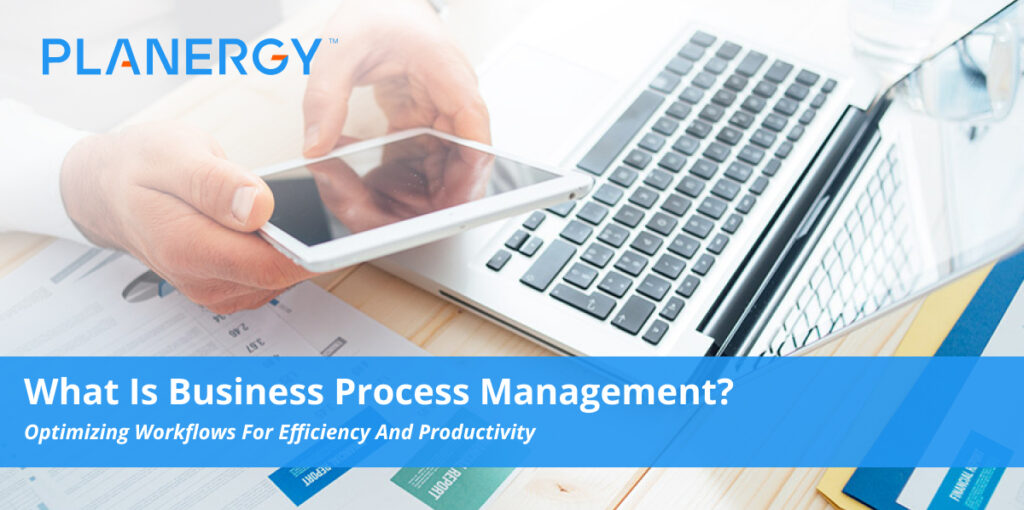Like a clock tower, the success of your business depends on how well a series of interlocking cogs—or, in this case, a set of activities we call processes—function together.
The business of doing business requires the same care and strategic thinking as conquering new markets or developing innovative products.
By using business process management, or BPM, you can streamline your workflow management to achieve a variety of process improvements to eliminate inefficiencies and maximize productivity.
Putting these process improvements into practice, however, takes more than good intentions.
To realize the full benefits of BPM in the era of digital transformation, you need the right technology and tools, and a thorough understanding of how BPM benefits your business.
Business Process Management Defined
For most modern companies, the concept of business process management is defined by the methods the company uses to develop, analyze, and refine the processes that support both essential business activities and overall business strategy.
Depending on the complexity of a given enterprise, each business unit, division, and department may have dozens of business processes it uses to transform materials or data into a form that supports the continued success of the business.
The primary goal of developing a business process management system is to optimize existing process performance through “reengineering” and ensure new processes and business rules are designed for maximum efficiency and efficacy from the start.
Generally speaking, BPM has three major classifications:
- Human-Focused BPM, which deals with processes requiring human interaction on the individual level. These processes include approval and task-focused workflows, and benefit immensely from automation and real-time tracking.
- Document-Focused BPM, centered around documents such as contracts, purchase requisitions, invoices, etc. These processes benefit from automation via tracking, templates, and workflow enhancements such as built-in reminders and automatic routing.
- Integration-Focused BPM, supporting the goal of connecting disparate applications in your existing software environment—e.g., enterprise resource planning (ERP), customer resource management (CRM), human resources management systems (HRMS), accounting and office suites, etc.—to create a cohesive whole that works smoothly without the need for human intervention. These processes use artificial intelligence and application program interfaces (APIs) to create fast, reliable connections that allow for process improvements to be implemented across business units and throughout organizations.
While achieving optimal efficiency can be challenging, the BPM lifecycle is fairly straightforward for all three types.
The general goal of optimizing process performance is supported through a cyclical series of events:
- A set of activities is identified and formalized as a business process, ideally with an eye toward optimal performance and efficiency. (process design)
- Each process is analyzed to identify areas in need of improvement. (Process Analysis)
- Each process is then put through several different scenarios to test performance. (Process Modeling)
- New processes are implemented (Process Execution). Existing processes are modified to incorporate suggested improvements. (Process Change)
- Each process is monitored for performance and efficiency to identify further necessary improvements. (Process Monitoring)
- Each process is periodically refined to implement improvements discovered during process monitoring and returned to the BPM cycle. (Continuous Improvement)
Rather than a single event, BPM should be regarded as an ongoing project management framework suitable for different challenges a company might face.
It can be adapted to handle both ongoing processes refinements (e.g., continuous improvement initiatives for departmental, division, and organizational efficiency) and ad hoc projects, such as the implementation of a new software package that don’t occur regularly but require the same attention to detail and focus on optimal returns as ongoing, company-wide initiatives.
BPM is about building continuous improvement into your workflow management, in support of your company’s competitive advantage and profitability through reduced waste, fewer errors, and greater efficiency and productivity.
Why BPM Matters
By giving leaders at all levels of your organization a complete picture of which business processes are working effectively (and which aren’t), business process management makes it easier to monitor existing processes, develop effective new ones, and ensure continuous improvement measures are implemented properly.
BPM is about building continuous improvement into your workflow management, in support of your company’s competitive advantage and profitability through reduced waste, fewer errors, and greater efficiency and productivity.
Effective business process management is a task with no end; in a marketplace defined by an ever-changing array of trends, technologies, regulations, and opportunities for innovation, BPM ensures your organization is up to speed and ready to thrive, rather than simply survive.
BPM Software in Procurement and Accounts Payable
Maximizing the efficiency and effectiveness of your business processes is especially important in the procurement and accounts payable functions.
Because all your company’s spend—both direct and indirect—flows through these two departments, making sure they’re operating at peak levels supports optimal productivity and profitability for your business.
Both procurement and accounts payable have multiple human-, integration-, and document-focused workflows that can be transformed into sources of not just productivity but significant value creation through automation.
The entire procure-to-pay (P2P) process works more smoothly, securely, and effectively when human error, inefficiencies, and bottlenecks are removed.
To achieve these improvements, procurement leaders in industries around the globe are investing in purpose-built procurement solutions that also serve as business process management suites (BPMS).
Equipped with artificial intelligence, advanced automation tools, and powerful analytics, business process management software systems help busy professionals take total control of process optimization, and full advantage of its benefits.
Combining technology-driven BPM tools with formalized continuous improvement transforms and elevates standard business process management into intelligent business process management, or iBPM.
This advanced approach brings together all three types of BPM through total integration of tech, human resources, and document/data management.
iBPM solutions, as part of a custom procurement solution like PLANERGY, offer:
- Full spend transparency to eliminate rogue spend, invoice fraud, and theft.
- Automated workflows that remove human error and needless delays.
- Staff resources and skills dedicated to high-value initiatives, rather than low-value, repetitive tasks.
- Reduced need for extra staff and support through task automation and software support self-service, respectively.
- Centralized data management and access using cloud-based servers for secure, leveled access for all stakeholders, whether on-premises or using mobile devices.
- Improved collaboration and communication.
- Improved project management in support of overall organizational goals.
- Value recovery through process optimization, e.g. more discounts and rebates captured from vendor early-payment incentives.
- More effective and complete digital transformation through easier integration with existing software environment.
- Deep data analytics providing actionable insights driving further process refinements in support of lean (i.e., optimally efficient) and continuous improvement. Consistent and constant monitoring of process performance, measured against key performance indicators (KPIs), allow for tactical and strategic changes for optimal short- and long-term productivity and profitability.
- Analytic tools also provide business intelligence from external data to support greater operational flexibility and speed in acting on opportunities for expansion, market penetration, and product innovation.
- Improved morale and user experience through enhanced user interface options, such as real-time data dashboards, role-based single-sign (SSO) access to the complete software environment, and data and document management tools such as drag-and-drop templates and auto-populating forms such as purchase requisitions from the central server.
- Higher customer satisfaction through greater responsiveness and efficiency.
Not every company has the same needs, naturally. That’s why choosing a purpose-built solution, such as the one offered by PLANERGY, is ideal for automating business processes.
You can automate and optimize with a BPM suite that has all the features that meet your requirements (and none of the ones that don’t), while still leaving room for additional expansion as your needs evolve.
Unlock Your Company’s Full Potential with Business Process Management
Are your business processes keeping time with the demands of the modern commerce? Without BPM, your company may be running behind the competition.
By formalizing your business process management system and putting it into practice with process automation using a BPM solution, you can be sure every “cog” in your company’s workflow clockworks is optimized for maximum value, efficiency, and performance.




